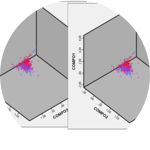About This Project
Musical perception is very important to neuroscience since can help solve hearing and other brain problems. To provide valuable experimental data to experts, we started an online listening experiment, where a massive number of participants will compare different sounds by pleasantness (consonance). The results will profoundly help neuroscience. We have more than 1000 views: if each viewer would have donated only 2$, we would have achieved the goal already. Click [Back the project] to donate now!
Ask the Scientists
Join The DiscussionWhat is the context of this research?
In our previous paper we show the possible reasons for the roots of our emotional reaction to music - Consonance.
The studies of Consonance usually considers the Consonance Pattern (or Consonance list), which is a list of pairs of two tones, ordered by pleasantness (we suggest that you check check our lab note "What is Consonance", for more details). Many scientists and musicians attempted the same, but they did not succeed, neither perfectly, neither completely to reproduce the Consonance list (Consonance pattern).
In our study mentioned above, we succeeded to perfectly and completely reproduce the Consonance Pattern, for the first time in 2500 years of history in studying this mystery.
What is the significance of this project?
The research of Consonance is important since it tells us how our hearing functions and that is needed not only to study music, but also to assist neuroscience in treatment of certain hearing problems or conditions.
The available data that we and the other scientists used in the past has 30 times weaker pitch resolution than our hearing limits. For that reason, our results, and those of other scientists, lack sufficient precision and that is why they are not too convincing.
To overcome the lack of precise data, we are starting a new experiment. The collected data will not only serve to validate our model, but it will be published and shared with other scientists. We hope that these results will even benefit studies that aim to solve hearing problems or conditions.
What are the goals of the project?
In this experiment we aim to collect a massive amount of data in order to more precisely test our hypothesis: neuroplasticity is the main cause of Consonance.
The experiment is designed around a website that will play two tones to the listeners. In every attempt, a different pair of tones will be played. For each pair, the listeners will choose which tone sounds more pleasant.
We will record all these responses, so at the end, we will be able to construct a new, more detailed Consonance list.
To obtain results with sufficient precision and confidence level, we need 576 pairs of tones to be compared. For each pair, we need at least 385 comparisons (a total of 221,760.)
To achieve that, we are starting a massive online participant recruitment campaign, using Google AdWords and YouTube.
Budget
In order to collect data with sufficient level of detail, at the very limit of human listening perception, we need to perform a massive listening experiment. The only way to do that is by on-line experiment. People, volunteers, from all around the World, will come to our website to perform listening tests - comparing the pleasantness of complex sounds.
Since this experiment is with human participants, we must request:
1. An approval from an Independent Research Ethics Board, and
2. Monitoring by that board, until the end of the experiment.
We need funding to cover the fees of the Research Ethics Board.
This experiment has other costs, enlisted below:
1. Development and maintenance of the website (already built, self-financed)
2. Web-hosting expenses (self-financed)
3. Advertisement campaign to recruit experimental participants (financed by a donation, secured)
Endorsed by
 Project Timeline
Project Timeline
This project is planned to last about one year. We need a massive amount of participants, and that requires a longer time for the experiment. To ensure at least partial success, we will split the study into 12 phases. Each phase will collect data with frequency resolution, double than the previous phase. More about the phases in the this lab note.
It is hard to predict the number of people that will participate and the timelines, so the milestones are only to report the progress.
Dec 13, 2017
Project Launched
Jan 01, 2018
Initial report - confirm the official start and recalculate estimations of the following milestones. The backers will be informed with the obtained (new) Consonance List.
Mar 01, 2018
Second report - expecting to complete Phases 1 and 2 (more about the phases in the lab notes). The backers will be informed with the obtained (new) Consonance List.
May 01, 2018
Third report - expecting to complete Phases 3 and 4 (more about the phases in the lab notes). The backers will be informed with the obtained (new) Consonance List.
Jul 01, 2018
Fourth report - expecting to complete Phases 5 and 6 (more about the phases in the lab notes). The backers will be informed with the obtained (new) Consonance List.
Meet the Team
Toso Pankovski
Toso Pankovski has an Engineer’s degree, Computer Science, Informatics, Automatics & Bio-cybernetics, obtained at Ss. Cyril and Methodius University in Skopje, Republic of Macedonia. Lives and works in Montreal, Canada.
He is a founder of BrainExperiments.com, a non-profit scientific organization that perform research in fundamental science.
Research interests:
1. Discovering neural network structures that solve and reproduce real-life neural phenomena
2. Research in musical perception and auditory neuroscience
3. Standardization of BCI (brain-computer interfaces)
4. Signal analysis, related to auditory perception
Peer-reviewed publications:
1. Emergence of the consonance pattern within synaptic weights of a neural network featuring Hebbian neuroplasticity, Biologically Inspired Cognitive Architectures, October 2017.
https://doi.org/10.1016/j.bica...
2. Fast calculation algorithm for discrete resonance-based band-pass filter, Alexandria Engineering Journal, July 2016
http://dx.doi.org/10.1016/j.ae...
Additional Information
If we succeed to re-validate our model with the newly collected much-more-precise data, that will not only provide a convincing result about the music, but it will benefit in our understanding of the brain. Why is that?
Currently, a strong debate is going on between neuro-scientists, those that are trying to decode the brain signals (the "neural code"). There are several "schools", but the most spread are the "rate code" and the "timing code".
Our model, if re-confirmed, will strongly support the "rate code", which is actually the classic way of understanding neuro-plasticity. This study could actually resolve this debate, or at least, offer such a detailed data, that will help brain scientists to validate their theories much more precisely and hopefully contribute in better understanding of the mysteries of the brain and mind.
You may actually take part in the experiment, yourself! Just visit the website http://BrainExperiments.com and follow the instructions - it is free, easy and fun.
Project Backers
- 15Backers
- 27%Funded
- $532Total Donations
- $35.47Average Donation


